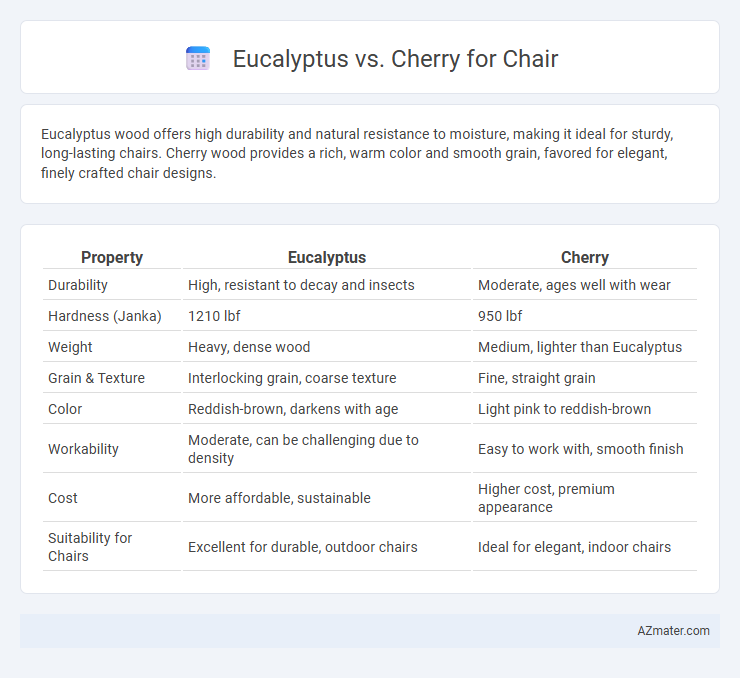Eucalyptus wood offers high durability and natural resistance to moisture, making it ideal for sturdy, long-lasting chairs. Cherry wood provides a rich, warm color and smooth grain, favored for elegant, finely crafted chair designs.
Table of Comparison
| Property | Eucalyptus | Cherry |
|---|---|---|
| Durability | High, resistant to decay and insects | Moderate, ages well with wear |
| Hardness (Janka) | 1210 lbf | 950 lbf |
| Weight | Heavy, dense wood | Medium, lighter than Eucalyptus |
| Grain & Texture | Interlocking grain, coarse texture | Fine, straight grain |
| Color | Reddish-brown, darkens with age | Light pink to reddish-brown |
| Workability | Moderate, can be challenging due to density | Easy to work with, smooth finish |
| Cost | More affordable, sustainable | Higher cost, premium appearance |
| Suitability for Chairs | Excellent for durable, outdoor chairs | Ideal for elegant, indoor chairs |
Introduction to Eucalyptus and Cherry Wood for Chairs
Eucalyptus wood is prized for its durability, sustainability, and attractive grain, making it a popular choice for chair construction in eco-friendly furniture. Cherry wood is renowned for its rich, warm reddish-brown color and fine, smooth texture, often used in high-end chairs for a classic and elegant appearance. Both woods offer strong structural properties suitable for seating, with eucalyptus providing resistance to moisture and decay, while cherry develops a deep patina over time, enhancing its aesthetic appeal.
Origins and Botanical Differences
Eucalyptus wood, native to Australia, comes from fast-growing hardwood trees belonging to the Myrtaceae family, characterized by its dense, durable grain and natural resistance to moisture and pests. Cherry wood, primarily found in North America and Europe, is derived from the Prunus genus of hardwoods, known for its fine, smooth texture and rich reddish-brown color that deepens with age. The botanical differences between Eucalyptus and Cherry influence their grain patterns, durability, and aesthetic appeal, making each wood distinct in furniture production, especially chair crafting.
Appearance and Grain Patterns
Eucalyptus chairs feature a tight, straight grain with a smooth texture and a warm, reddish-brown hue that darkens over time, offering a clean, modern look. Cherry wood boasts a rich, smooth grain with subtle waves and a deep, reddish tone that develops a rich patina and enhances the chair's elegance. Both woods provide distinctive visual appeal, with eucalyptus emphasizing simplicity and cherry highlighting classic sophistication.
Strength and Durability Comparison
Eucalyptus wood offers high strength and excellent durability due to its dense, hard fibers, making it resistant to wear and environmental factors ideal for chair construction. Cherry wood, while slightly softer, provides good durability combined with natural resistance to decay and a smooth finish, resulting in comfortable yet sturdy chairs. When comparing strength, eucalyptus generally surpasses cherry in hardness and impact resistance, but cherry excels in aging gracefully with a rich patina that enhances chair aesthetics over time.
Workability and Ease of Crafting Chairs
Eucalyptus wood offers excellent workability for chair crafting due to its medium density and straight grain, allowing for smooth cutting and shaping with minimal tool wear. Cherry wood is favored for ease of crafting chairs because of its fine, even texture and natural luster, enabling detailed carving and effortless sanding. Both woods respond well to hand and machine tools, but cherry's consistent grain often results in cleaner finishes and fewer splinters during intricate joinery.
Sustainability and Environmental Impact
Eucalyptus wood offers a sustainable choice for chair manufacturing due to its fast growth rate and ability to be harvested without long-term deforestation, making it an eco-friendly option. Cherry wood, while prized for its durability and rich color, grows more slowly and is less renewable, which can lead to higher environmental impact through resource depletion. Choosing eucalyptus supports lower carbon footprints and promotes sustainable forestry practices, whereas cherry may contribute to ecosystem strain if not responsibly sourced.
Cost and Availability
Eucalyptus wood for chairs offers a budget-friendly option due to its rapid growth and widespread availability, making it cost-effective compared to cherry wood. Cherry wood commands higher prices because of its slower growth, limited supply, and rich aesthetic appeal, which increases its demand in fine furniture markets. Availability of eucalyptus is generally consistent across global markets, whereas cherry wood can be region-specific and more seasonal, affecting both price and procurement timelines.
Maintenance and Longevity
Eucalyptus wood, known for its natural resistance to moisture and insects, typically requires less frequent maintenance compared to cherry wood, which needs regular polishing to preserve its rich color and prevent surface scratches. Cherry wood's aging process enhances its aesthetic appeal over time, but it remains more susceptible to dents and exposure damage, necessitating cautious upkeep. Both hardwoods offer durability, yet eucalyptus may provide longer-lasting resilience in humid or outdoor environments, while cherry excels in controlled indoor settings.
Aesthetic Appeal and Design Versatility
Eucalyptus wood offers a warm, natural tone with a smooth grain that complements both rustic and modern chair designs, making it highly versatile for varied aesthetics. Cherry wood is renowned for its rich, reddish hue and fine grain that deepens over time, lending a classic and elegant appeal to traditional and sophisticated chair styles. Both woods provide distinct visual qualities, with eucalyptus suited for casual, contemporary looks and cherry favored for timeless, refined furniture craftsmanship.
Best Uses: Which Wood to Choose for Your Chair
Eucalyptus wood offers high durability and natural resistance to moisture, making it ideal for outdoor chairs and furniture exposed to weather. Cherry wood, with its smooth grain and rich reddish-brown hue, excels in indoor chairs where aesthetic appeal and fine craftsmanship are prioritized. For outdoor use, eucalyptus is the best choice due to its resilience, while cherry wood is preferred for elegant indoor seating.

Infographic: Eucalyptus vs Cherry for Chair
 azmater.com
azmater.com